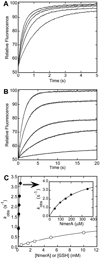Direct measurement of mercury(II) removal from organomercurial lyase (MerB) by tryptophan fluorescence: NmerA domain of coevolved γ-proteobacterial mercuric ion reductase (MerA) is more efficient than MerA catalytic core or glutathione
- PMID: 20722420
- PMCID: PMC3042367
- DOI: 10.1021/bi100802k
Direct measurement of mercury(II) removal from organomercurial lyase (MerB) by tryptophan fluorescence: NmerA domain of coevolved γ-proteobacterial mercuric ion reductase (MerA) is more efficient than MerA catalytic core or glutathione
Abstract
Aerobic and facultative bacteria and archaea harboring mer loci exhibit resistance to the toxic effects of Hg(II) and organomercurials [RHg(I)]. In broad spectrum resistance, RHg(I) is converted to less toxic Hg(0) in the cytosol by the sequential action of organomercurial lyase (MerB: RHg(I) → RH + Hg(II)) and mercuric ion reductase (MerA: Hg(II) → Hg(0)) enzymes, requiring transfer of Hg(II) from MerB to MerA. Although previous studies with γ-proteobacterial versions of MerA and a nonphysiological Hg(II)-DTT-MerB complex qualitatively support a pathway for direct transfer between proteins, assessment of the relative efficiencies of Hg(II) transfer to the two different dicysteine motifs in γ-proteobacterial MerA and to competing cellular thiol is lacking. Here we show the intrinsic tryptophan fluorescence of γ-proteobacterial MerB is sensitive to Hg(II) binding and use this to probe the kinetics of Hg(II) removal from MerB by the N-terminal domain (NmerA) and catalytic core C-terminal cysteine pairs of its coevolved MerA and by glutathione (GSH), the major competing cellular thiol in γ-proteobacteria. At physiologically relevant concentrations, reaction with a 10-fold excess of NmerA over HgMerB removes ≥92% Hg(II), while similar extents of reaction require more than 1000-fold excess of GSH. Kinetically, the apparent second-order rate constant for Hg(II) transfer from MerB to NmerA, at (2.3 ± 0.1) × 10(4) M(-1) s(-1), is ∼100-fold greater than that for GSH ((1.2 ± 0.2) × 10(2) M(-1) s(-1)) or the MerA catalytic core (1.2 × 10(2) M(-1) s(-1)), establishing transfer to the metallochaperone-like NmerA domain as the kinetically favored pathway in this coevolved system.
Figures








References
-
- Morel FMM, Kraepiel AML, Amyot M. The chemical cycle and bioaccumulation of mercury. Annu. Rev. Ecol. Syst. 1998;29:543–566.
-
- Clarkson TW, Magos L. The toxicology of mercury and its chemical compounds. Crit. Rev. Toxicol. 2006;36:609–662. - PubMed
-
- Casas JS, Jones MM. Mercury(II) complexes with sulfhydryl containing chelating agents: stability constant inconsistencies and their resolution. J. Inorg. Nucl. Chem. 1980;42:99–102.
-
- Cheesman BV, Arnold AP, Rabenstein DL. Nuclear magnetic resonance studies of the solution chemistry of metal complexes. 25. Hg(thiol)3 complexes and Hg(II)-thiol ligand exchange kinetics. J. Am. Chem. Soc. 1988;110:6359–6364.
-
- Zalups RK, Ahmad S. Handling of cysteine S-conjugates of methylmercury in MDCK cells expressing human OAT1. Kidney Int. 2005;68:1684–1699. - PubMed
Publication types
MeSH terms
Substances
Associated data
- Actions
- Actions
Grants and funding
LinkOut - more resources
Full Text Sources
Medical
Miscellaneous

